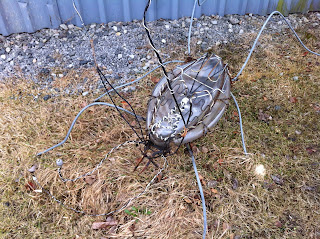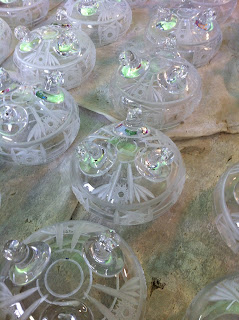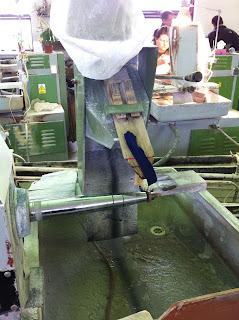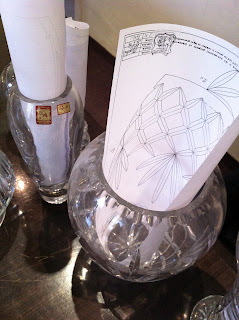Sorry for the long delay!
…the past few days in Prague have been rather hectic and prevented my
more frequent updates. These updates
will be up shortly!
On Thursday of this week, we made our first company visit in
the Czech Republic. We took a bus about
an hour west of town to visit a company by the name of Rückl Crystal. This was a crystal making factory that
produced low quantity, high quality crystal products. All products produced by Rückl
are hand-blown and crafted. The company
began in 1903 as a private family company.
After World War II, like most other companies under the new Soviet rule,
it was nationalized and re-named.
Surviving through the years, and entering 1992, the company was finally re-privatized
by Mr. Rückl
himself. Today it stands as a testament to
Czech craftsmanship and entrepreneurial spirit.
More history can be found using the side link of this blog.
 |
| Our Plant Tour Guide |
Today, the company employs thirty crystal blowers and twenty
five glass cutters. They are the last firm
in the Czech Republic that produces hand blown crystal. Their high quality and ability to customize
products (such as major trophies) make them competitive in what would seem like
a very intimidating and unstable market.
The absence of automation in the manufacturing processes would seem to
be a major disadvantage, but despite this, they remain successful. The diversity of their customers and market
helped them to survive more recent economic downturns.
One of the company’s major concerns going into the future is
the sustainability of their workforce.
As was the trend at all of our other company visits in Austria, the
younger working class appears to be disinterested in working at this level of…
work. Recent training programs have
proven marginally successful. The youth
who do finish training sometimes even leave the area and do not enter work. Since crystal manufacturing involves refining
a craft and art, it takes time and dedication by interested workers (three
years minimum). Only the future will
tell just how the youth’s disinterest will affect the company. In the mean time, Rückl will continue to work on
recruiting a younger work force in the hopes that their tradition continues.
The manufacturing process was very intriguing to
observe. Each step involved care and
precision. In general, the work
atmosphere was very relaxed. Workers
wore sandals and t-shirts. The shop was
also rather hot and dusty. It certainly
made me feel like I took a step back in time.
Production began at a large furnace where globs of molten crystal were
blown into forms. Following this, they
were cooled and trimmed. After some
cutting and etching processes, they were then polished and finished. The results were astounding! The company sticker and higher price were
certainly understandable after observing the care each piece was given in the
workshop. I will post a video soon to
outline this process.
 |
| Final Q&A Session with Company Representative |
After our company tour, we had the opportunity to talk
briefly with a sales representative before heading to lunch in a nearby café. She offered some more insight on the firm,
its history, and current status.
Following lunch, we drove back into town for a very short break.
At 2:00pm, we took a walking tour of Prague. Our guide started us off at the top of a
large hill in what is known as “Lesser Prague”.
Here there was a monastery by the name of Strahovský Cloister. An astounding view of the city could be seen
from these heights! We then walked down
the hill to visit the Prague Castle and St. Vitus Cathedral. Both were incredible structures and the
architecture was amazing to behold. They
were both towering and their respective histories very interesting. We were given backgrounds on both the
religious and political backgrounds of the city. After moving past the castle, we traveled down
to the river to see the Charles Bridge.
This is the most famous bridge in Prague. It’s corner stone was laid on September 7th
of 1357 at 5:31am. This was said to have
been lucky due to the numbers in that date forming a perfect pyramid. 1357-9-7-5:31
Until 1841 it was the only bridge attaching both sides of the city
across the river. Since then, more
bridges have been constructed and Charles Bridge was turned into a strictly
pedestrian bridge. It contains many
religious statues and figures, include that of St. John of Nepomuk, patron of
the Czech Republic, who has an interesting history with the city and
bridge. He was martyred on the bridge by
the king not long after he heard a confession by the queen. Apparently the confession that day had been
longer than usual, and the king became suspicious. He then confronted St. John about the
confession, but was given no details. In
anger, he had the saint thrown into the Vltava River. The five stars above the saint represent the
stars that hovered over the river on the night of his murder.
 |
| Our Tour Guide |
 |
| St. John of Nepomuk at St. Vitus Cathedral |
 |
| Changing of the Castle Guard |
 |
| Prague Street Tram |
 |
| Charles Bridge |
 |
| St. John of Nepomuk on Charles Bridge |
 |
| It is good luck to rub this image of St. John. |
 |
| Statue of King Charles |
After visiting the bridge, we entered the old town square
where we ended the tour at the famous Astronomical Clock. The tour was fantastic. I think I could have spent about a week
getting a more in-depth tour of the city if it were possible. The richness of history was visible at every
turn.
 |
| Astronomical Clock |
Splitting from the group at 6:00pm, a large portion of us
headed to a joint called “The Pub” for dinner.
Here were able to order traditional Czech food and pour our beer from
taps built right into the tables! How
about that for a concept? My meal was
better than the pilsner beer, however.
It was a Czech stable… beef sirloin, gravy, and dumplings. It reminded very much of a similar dish my
Aunt had cooked for my siblings and I several years ago. She had spent some time in Prague when she
was younger and knew a thing or two about the Czech culinary arts. I now had verification that she indeed could
do justice to the delicious foods available in the Czech Republic!
 |
| Svíčková na smetaně (Marinated Beef Sirloin) |










































































No comments:
Post a Comment